Why did the Jews reject Jesus if He was the legitimate Jewish Messiah?
An often cited reason by commentators for the Jewish religious establishment’s refection of Jesus as Messiah was Jesus’ failure to set up the Messianic Kingdom, but there is no place in the Gospels that this reason is given. There are two reasons found in the Bible: one is stated and the other is the actual reason. The stated reason is that the Pharisees concluded after their investigation of Him that Jesus was demon possessed (Matt.12). The actual reason was that Jesus rejected Pharisaism, evidenced by His numerous acts of healing and teaching throughout His public ministry, that expressly contradicted Pharisaic doctrine. The Pharisees were convinced that the true Messiah would be a Pharisee in every way and he would complete the Pharisaic Law (as opposed to Mosaic Law) handed down to them by their forefathers. To understand the difference between Pharisaic Law and Mosaic Law, a little background history is in order.
Pharisaic Law arose from a series of historical events following the Jews’ return from the Babylonian captivity, which led to the elevation, by the time of Jesus, of Pharisaic Law equal to and in some cases more authoritative than the Mosaic Law. However, Pharisaic Law was man-made laws, regulations, traditions, and interpretations of the Mosaic Law that covered God’s given Law to Moses under thick layers of man’s traditions. So much so that Jesus remarked to the Pharisees that by their traditions they have made the Law of God of no effect by their traditions (Matt.15:1-9). This result transpired over the course of about 400 years following the Jews’ return from Babylonian captivity.
What started out with good intentions ended in tragedy by leading countless Jews in Jesus’ day, and Jews up to this very moment, to reject their true Messiah Jesus. The good intention was to do anything necessary to avoid a future divine judgment like the Babylonian captivity they had just endured. After their release, in hind sight, they concluded that the reason God sent them into exile was their repeated violation of the Mosaic Law. About that fact, they were absolutely correct. So what was their solution?
The First Wave of Scribes: from Ezra (450 BC) to Hillel (30 BC)
The First Generation of Sopherim 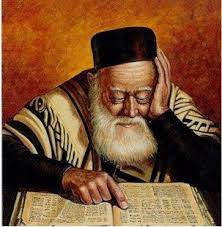
Under the leadership of Ezra (the Ezra from the Old Testament book Ezra) was created the School of the Scribes or Sopherim (Sopher [singular]; Sopherim [plural]). After the Babylonian captivity, and realizing their judgment came from God for their violations over hundreds of years before judgment falling, Ezra created a school composed of spiritual leaders of Israel. Their task was to examine and expound upon all 613 commandments of the Mosaic Law to determine what constituted obedience or disobedience. They would then communicate theses rulings to the lay-people so that they could comply without confusion to avoid another divine discipline like the Babylonian captivity. This was good and proper for them to do, and in principle, what constitutes godly leadership even today for the Christian church, to help Christians follow God’s Word. However, problems arose when future generations went beyond the initial purpose of the original Sopherim commission. These problems created tragic results for Jews the world over.
The Second Generation of Sopherim 
The next generation was not content with expounding (interpreting) the Mosaic Law, they wanted to build a “fence around the Law.” Their thinking was that if they constructed a buffer in the form of rules and regulations required by Jews to obey, Jews could be guilty of breaking the rules of the buffer, without being in violation of breaking the Mosaic Law itself. In other words, Jews might break the ‘fence’ (e.g., Pharisaic Law) without the possibility of breaking the Mosaic Law, and avoid any future judgment of God similar to the Babylonian exile.
The overriding operating framework of this body was this: a Sopher could disagree with another Sopher, but no Sopher could disagree with the Torah. Since disagreements did occur, what Sopheric Law was proper to include as a plank in the ‘picket-fence’ was determined by a vote. Once the majority vote decided which option was the correct one to add to the ‘fence,’ all Jews everywhere were expected to obey this new regulation. Arriving at the various Sopheric laws from the God-given Torah was by using Talmudic logic called ‘pilpul’ (meaning ‘peppery’ or ‘sharp’) which is as follows: given any one command in the Torah, how many rules can be derived from that one commandment.
For example, Moses commanded the Jews not to boil goat in the milk of its mother (Ex.23:19). In Canaanite Baal worship, when a first-born kid goat was born, they would milk the mother and boil the newborn kid in its mother’s milk as a first-fruits offering to Baal. God forbade this because He did no want the Jews to emulate the Canaanite practice that was part of their pagan religion. The original commandment in Ex.23:19 was given to Moses in about 1,400 BC, by the time The School of the Sopherim is determining their rules, it is now about 400 BC, that is about 1,000 years after Moses. By this time, there are no Canaanites around to practice this aspect of their former religion, so the original purpose for the commandment had long been forgotten. But when the Scribes (Sopherim) came upon this commandment in the Torah, the rabbinic logic used, (e.g., pilpul) required them to create as many rules as possible designed to avoid ever breaking Ex.23:19.
They carried this to an extreme. They concluded that eating meat and dairy could conceivably put one in danger of ‘boiling’ a kid in its mothers milk since nobody would know the origins of the meat or milk (they might be related). So the rule, to this day, states that a Jew cannot eat dairy and meat together, they must be consumed at least four hours apart. (If you enter any McDonald’s in Israel, you will not find a cheese burger on the menu. Even if you are a Gentile requesting it, they will not serve it to you.) Their logic went further, they figured it might be possible for one to unwittingly eat milk with dairy if the plate they used was not perfectly cleansed. That is, some imperceptible piece of meat or dairy could remain on a ‘clean’ dish and if milk and dairy accidentally came in contact, one could be in violation. Therefore, the rule states that two sets of dishes must be used, one for meat and one for dairy. If a plate ever gets mixed up, they are required to store it away, never use it again or give it to a Gentile. This process resulted in thousands of added commandments to the original 613 Mosaic Laws. The period for the first wave of Scribes spanned from Ezra (450 BC) to Hillel (30 BC).
The Tannaim from Hillel (30 BC) to Rabbi Judah HaNasi (220 AD)
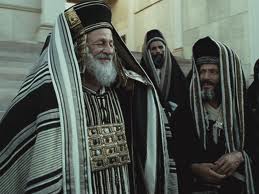 The next wave of rabbis were called Tannaim (plural) Aramaic for Teacher (Tanna) examined the work of the Sopherim and decided that it left too many holes in the ‘fence around the Torah.’ Thus, the Teachers continued the process of adding even more regulations from the death of Hillel (30 BC) until 220 AD, the death of Rabbi Judah HaNasi.
The next wave of rabbis were called Tannaim (plural) Aramaic for Teacher (Tanna) examined the work of the Sopherim and decided that it left too many holes in the ‘fence around the Torah.’ Thus, the Teachers continued the process of adding even more regulations from the death of Hillel (30 BC) until 220 AD, the death of Rabbi Judah HaNasi.
The Tannaim operated on a different principle than the Sopherim. They said Tanna can disagree with another Tanna, but they cannot disagree with the Sopher. This principle elevated the regulations of the Sopherim to equal status as the Torah. So by about 30 BC, roughly 60 years before the start of Jesus’ public ministry, rabbinic rules and regulations carried equal authority with the Mosaic Law. The Tannaim had to justify why the rules invented by men carried equal authority as the God-given Torah, so they invented the existence of the Jewish Oral Law. They said that Moses received two sets of Laws on Mount Sinai: the Written Law (Torah) consisting of 613 commandments and the Oral Law, consisting of the rules and regulations of the School of Sopherim and School of Tannaim.
The reason they called it the Oral Law was because from 450 BC to 220 AD (i.e., from the Sopherim to the Tannaim) none of the rulings were written down. They were memorized and passed down through the generations.[ref] In fact, would-be ultra-orthodox Hasidic rabbis, in Poland, from as recent as the 19th century were required to memorize the entire Torah, in Hebrew, by the age of 13; they were required to memorize the entire Old Testament in Hebrew, by the age of 18. At the age of 21, the ‘Final Exam’ consisted of being handed a Hebrew Bible, into which another man randomly hammered a nail completely through. The candidate was then required to recite from memory, every word that the nail pierced, in page by page, chronological order, from the beginning of the Bible to the end.[/ref] So in one respect they were correct to call it the Oral Law, however, they were wrong in their claims of its origins. They said it came from God to Moses; Moses to Joshua; Joshua to Judges; Judges to Prophets; Prophets to Sopherim; and Sopherim to Tannaim. In reality, they originated with Ezra and continued to the Tannaim and beyond. God and Moses had nothing to do with it.
The Tannaim liked the think of themselves as ‘trailblazers’ because they thought they were blazing new trails for Judaism. The Apostle Paul used this term to describe himself before his conversion, indicating Paul was a Pharisee, moreover a Tanna or ‘trailblazing Teacher.’
…and I was constantly blazing a pioneer path, outstripping in Judaism many in my own age in my race… (Gal.1:14; Wuest NT)
Most translate this Greek word prokopto as ‘advancing’ but the Wuest New Testament brings out the idea of trailblazing better (prokopto [Strong’s #: NT4298] “to drive forward as if by beating” from pro (NT4253) ‘in front, forward’ and kopto (NT2875) ‘to chop’). By 220 AD their existed fewer and fewer rabbis to pass the Oral Law onto, so it was decided to write the Oral Law down, which ended to era of the Tannaim.
The Amoraim (‘Teachers’) from 220 AD to about 500 AD
The next wave a rabbis were the Amoraim (plural) for Teacher (Amora) in Aramaic. They looked at the work of the Tannaim and concluded that their work left yet more holes in the ‘fence around the Torah.’ Their operating principle was similar to the Tannaim before them, which said that an Amora could disagree with another Amora, but neither could disagree with the Tannaim. Like the Sopherim and Tannaim before them, this principle elevated the rules of men to equal authority with the Written Law of Moses.
The result of these events and rulings created the foundational documents of Orthodox Judaism. But the only work that effects our study of Jesus is the Mishnah since the Gemara existed later.
- The work of the Sopherim and Tannaim = Mishnah
- Compiled from 450 BC to 220 AD or from Ezra to rabbi Judah haNasi
- The Mishnah is written n Hebrew
- In consists of about 1,500 pages in book form
- The work of the Amoraim = Gemara
- The Gemara was written in Aramaic
- About the size of the Encyclopedia Britannica (i.e., 32 volumes; about 40 million words)
- The Mishnah + Gemara = Talmud
So what does any of this have to do with the issue at hand: why did the Jews of the first century reject Jesus if He was the true Jewish Messiah?
Quite simply, it was the content of the Mishnah rulings and their elevation to equal authority to the Word of God that led the religious leaders astray and consequently, the general population of Jews to also reject Jesus as Messiah. The people followed the lead of their leaders.
According the Pharisee’s concepts, the Messiah would be a Pharisee. Thus, the Messiah would be in submission to the Mishnah, and be involved in completing the Mishnah. As this brief history showed, the rabbis always thought that the work of plugging up holes in the ‘fence around the Torah’ was never completed by previous generations. However, they were convinced the Messiah would plug every hole by completing the work they started. Thus, any prophet who violated any part of the Mishnah rulings or who taught doctrine contrary to that established by the Sopherim and Tannaim could NOT be the Messiah, in the eyes of the Pharisees.
By creating and canonizing the Mishnah, various commandments in the written Law of Moses, were changed to the extent that keeping them went beyond what God had originally intended.
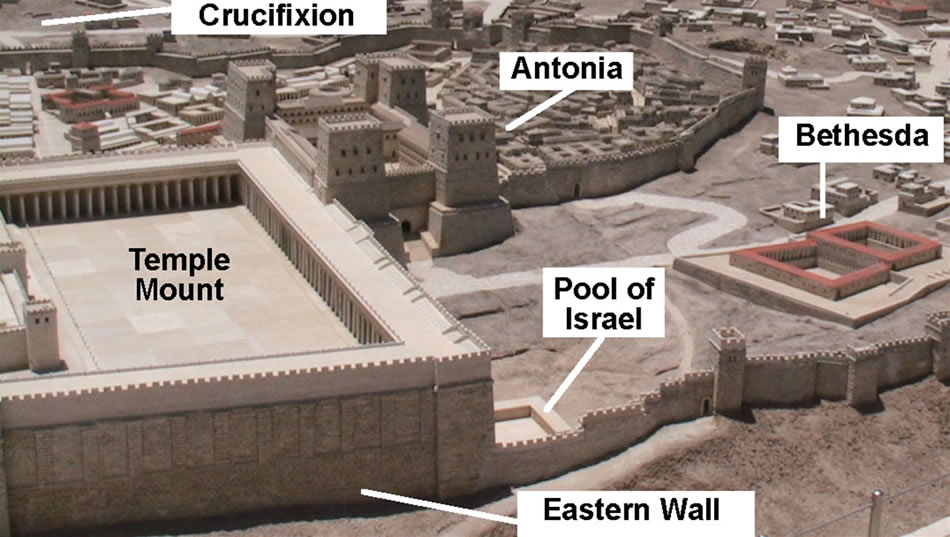
Pool of Bethesda:A scale model of the city of Jerusalem during the time of Jesus showing the Pool of Bethesda relative to the Temple Mount complex. [NOTE: the place of the crucifixion marked above differs from that of Gordon’s Calvary; the crescent shaped shadow just outside city wall (top right corner of picture).]
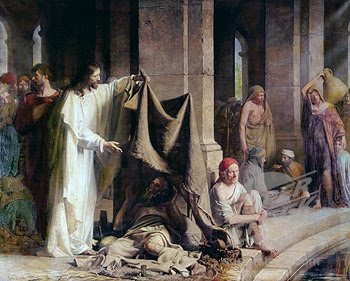 For example: the Sabbath. The Pharisees taught that is was illegal to heal anyone on the Sabbath, unless the person needing help was in a life threatening condition. However, Jesus healed a man on the Sabbath from a non-life threatening ailment which put Him at odds with the Pharisees who were investigating Jesus to determine the validity, by their standards, of Jesus’ claims to be the Messiah. In John 5 Jesus heals a paralyzed man on the Sabbath at the Pool of Bethesda (see picture above) and tells him to take up his bed and walk. According to the Pharisees, this was a double violation of the Sabbath: for healing on the Sabbath from non-life threatening condition and for telling the healed man to carry his bed on the Sabbath. As a result, “…the Jews (e.g., the religious leaders, not the general population) persecuted Jesus because He did these things on the Sabbath.” (Jn. 5:8-10; 16). But rather than cowering amid the persecution, Jesus turns up the heat by making a clear declaration of deity,
For example: the Sabbath. The Pharisees taught that is was illegal to heal anyone on the Sabbath, unless the person needing help was in a life threatening condition. However, Jesus healed a man on the Sabbath from a non-life threatening ailment which put Him at odds with the Pharisees who were investigating Jesus to determine the validity, by their standards, of Jesus’ claims to be the Messiah. In John 5 Jesus heals a paralyzed man on the Sabbath at the Pool of Bethesda (see picture above) and tells him to take up his bed and walk. According to the Pharisees, this was a double violation of the Sabbath: for healing on the Sabbath from non-life threatening condition and for telling the healed man to carry his bed on the Sabbath. As a result, “…the Jews (e.g., the religious leaders, not the general population) persecuted Jesus because He did these things on the Sabbath.” (Jn. 5:8-10; 16). But rather than cowering amid the persecution, Jesus turns up the heat by making a clear declaration of deity,
But Jesus answered them, ‘My Father works even until now and I work.’ For this cause therefore the Jews sought the more to kill Him because He not only broke the Sabbath but also called God His Father, making Himself equal with God. (Jn.5:17-18)
Though not the subject at hand, it must be said that Jesus calling God His Father was a clear and direct claim to deity. Many critics assert that Jesus never claimed to be God. But this is not true. Jesus often made clear claims for Himself that are only attributable to God. Here is one example: Jesus said God was His Father. Pseudo-Christian cults (Mormons, Jehovah’s Witnesses) usually say since Jesus claimed to be God’s Son, He was somehow demoting Himself to something less than full deity. But this claim is false. The very fact that Jesus did claim to be God’s Son proved He was claiming equality with God. How so? Anyone reading this is either a son or daughter. Picture your birth parents admiring you through the window while you rest in the new born crib among the other new borns in the hospital. A stranger approaches and says, “Is that your son?” Your parents proudly say, “Yes, he’s our only son.” The stranger says, “I know you’re proud of that “person” in the crib, but I’ve got some bad news.” Your parents says, “What is it?” He says, “That so called ‘baby’ is not fully human. He’s sub-human at best. He can’t be fully human because he’s merely your son.” And after punching the stranger in the nose, your father says, “You fool! The fact that he is my son, proves he’s fully human. He’s got my genes in his DNA. Since I’m fully human, so is my son!” You can clearly see the point – so could the Pharisees that heard Jesus. The Pharisees who heard Jesus make this claim, were far more logical and biblically literate than Mormons or Jehovah’s Witnesses, because they knew immediately that Jesus was claiming equality with God, that was an additional reason for their desire to kill Jesus.
But returning to our point. Jesus clearly makes a distinction between the correct understanding of the Mosaic Law commandment regarding what constituted obeying the Sabbath, and it was contrary to the Pharisees (i.e., the Mishnah). What the Law of Moses forbade was working in one’s vocation, their line of work, on the Sabbath, not carrying their bed. But this commandment was changed by centuries of amendments placed upon it by the Sopherim and Tannaim. In addition, the Mishnah was elevated to equal status as the Word of God. Furthermore, the identification of the true Messiah was missed because of the acceptance by Jewish religious leaders of these two historical developments: the creation of the Mishnah and its elevation to equal status as God’s Word.
Jesus makes this very point in His defense further on in John 5:45-47. Jesus, still speaking to the Pharisees says,
Think not that I will accuse you to the Father: there is one that accuses you, even Moses, in whom you trust. For had you believed Moses, you would believed Me: for he wrote of Me. But you believe not his writings, how shall you believe My words?
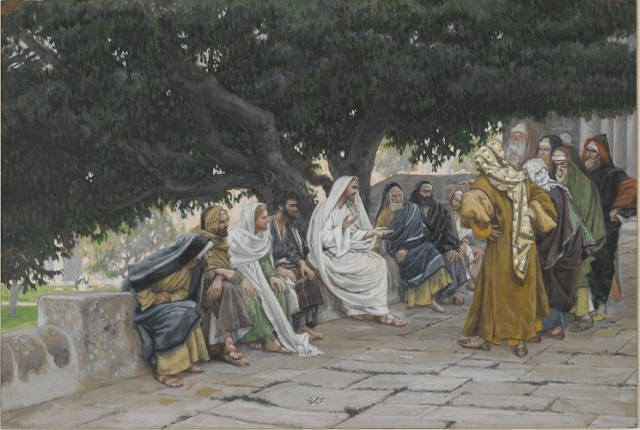 This is a very significant response to and judgment of the Pharisees and their Mishnah. These were Pharisees – they devoted their entire life to the knowledge and study of the Law of Moses. To qualify as a candidate, they had to memorize the entire Old Testament. What did Jesus mean by saying, “For had you believed Moses, you would believed Me.” Jesus was alerting them to their major fallacy: elevating man-created regulations and interpretations to equal status with God’s word. Jesus is saying that the Mishnah is contrary to the Written Law of Moses, so much so, that by believing in the Mishnah meant choosing to reject the Law of Moses, which is causing them to miss the identity of the long promised and awaited Messiah. Reiterating Jesus’ words, “…there is one that accuses you, even Moses…had you believed Moses, you would believe in Me: for he wrote of Me. But you believe not his writings, how shall you believe My words?” (Jn.5:45-47)
This is a very significant response to and judgment of the Pharisees and their Mishnah. These were Pharisees – they devoted their entire life to the knowledge and study of the Law of Moses. To qualify as a candidate, they had to memorize the entire Old Testament. What did Jesus mean by saying, “For had you believed Moses, you would believed Me.” Jesus was alerting them to their major fallacy: elevating man-created regulations and interpretations to equal status with God’s word. Jesus is saying that the Mishnah is contrary to the Written Law of Moses, so much so, that by believing in the Mishnah meant choosing to reject the Law of Moses, which is causing them to miss the identity of the long promised and awaited Messiah. Reiterating Jesus’ words, “…there is one that accuses you, even Moses…had you believed Moses, you would believe in Me: for he wrote of Me. But you believe not his writings, how shall you believe My words?” (Jn.5:45-47)
This is why in my opening remarks in this section, I said what started out with good intentions (Ezra expounding on the Torah and communicating this to the lay-people), ended in tragedy because the Mishnah rulings and its understanding of the Messiah resulted in the Jewish religious leaders and the majority of Jewish people to reject their Messiah. Had they simply stayed true to the Written Word of God (e.g., the Law, the Prophets, the Writings) they would have accepted Jesus as their Messiah.
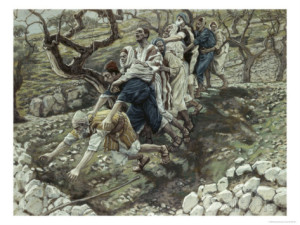 But their reverence for the man-made Mishnah blinded them to the truth of God’s Word which clearly identified Jesus as the long awaited Messiah. Jesus said of the Pharisees they are “blind leaders of the blind. And if the blind lead the blind, both shall fall in the ditch.” (Matt.15:14).
But their reverence for the man-made Mishnah blinded them to the truth of God’s Word which clearly identified Jesus as the long awaited Messiah. Jesus said of the Pharisees they are “blind leaders of the blind. And if the blind lead the blind, both shall fall in the ditch.” (Matt.15:14).
Not all the Jews rejected Jesus
The Apostles and the minority of Jews among the lay-people did accept Jesus as Messiah because they rejected the Mishnah’s position on the Law and the Messiah. When the Apostle Andrew believed in Jesus, he told his brother Peter, “We have found the Messiah.” (Jn.1:41) And when Philip believed in Jesus, he said to Nathanael, “We have found Him, of whom Moses in the Law, and the Prophets (i.e., the entire Old Testament), did write, Jesus of Nazareth, the son of Joseph.” (Jn.1:45).
So it is misleading to say that Jesus cannot be the Jewish Messiah since the Jews rejected Him. First, the entire Jewish population did not reject Jesus. The Apostles and disciples who believed in and followed Jesus in the Gospels were Jewish. The entire first century church was Jewish, which caused a problem when Gentiles were receiving Jesus as a result of Peter’s and Paul’s missionary efforts. The first Church Council convened to address the question of whether Gentiles had to first become a proselyte Jew before they could become a Christian (Acts 11, 15).
If the Christianity was originally Jewish, why is it predominantly Gentile now?
Most Christians, by this time in Church history, readily acknowledge the Jewish roots of Christianity. I think many, in an effort to build a bridge of communication with a Jewish unbeliever, will say something like, “Well, did you know Jesus and all the Apostles were Jewish?” I also believe that most Gentile Christians assume the cause of the transition from an all Jewish Church to a predominantly Gentile Church was merely Gentiles chose to believe, whereas most Jews choose not to believe. In general, that’s correct. But it’s important for Christians to know the historical evens that contributed to the transformation of the Church resulting in its disconnect from its Jewish origins.
To be sure, the claims of Jesus about His Person and work, immediately draws a line between those who believe verses those who don’t. No one can be neutral or ambiguous about Jesus: you’re either for Him or against Him (Matt.12:30). This distinction caused almost immediate persecutions from the unbelieving Jews, documented in the Book of Acts (see Acts 4 onward). Persecutions by unbelieving Jews continued and increased, even to the point of some Jewish Believers contemplating departing from Jesus and returning to Rabbinic Judaism (see Book of Hebrews). But these tensions reached a breaking point following the destruction of Jerusalem and the Temple in 70 AD. Again, a brief review of history in in order.[ref] See S. Telchin, Betrayed, chapter 10.[/ref]
The eighth Roman governor of Judaea, Flavius, imposed a severe tax of 17 talents of gold (over $2 million) to be payed from the Temple treasury. After other similar mistreatments, this triggered a Jewish revolt that started in 66 AD. The Jewish rebels fought the Romans for over three years, until in 70 AD the city of Jerusalem and the Temple was destroyed resulting in 1.1 million Jews being killed. The survivors were enslaved or imprisoned, awaiting to be killed by beast or Roman in the arenas for Roman amusement. However, Jewish Christians survived the destruction without loss.
How did the Jewish Believers escape the same fate as the unbelieving Jews? When the revolt began, the Roman General Cestus Gallus brought his troops from Caesarea to Jerusalem and surrounded the city. But Cestus underestimated the Jewish resistance, and did not realize bands of Jews were cutting off his supply lines for his troops. Running low on supplies, he headed back to Caesarea to replenish. On the way back, a band of Jewish rebels attacked Cestus and he was killed. Meanwhile, Jewish Believers recognized Romans surrounding Jerusalem as the fulfillment of Jesus’ warning,
But when you see Jerusalem compassed about by armies…flee to the mountains (Luke 21:20).

Therefore, about 20,000 Jewish Believers from Jerusalem and about 80,000 throughout Israel, used the Roman retreat to replenish supplies, as the opportunity to flee Jerusalem for Pella, in obedience to Jesus’ warning. Pella is one of the cities of the Decapolis, located on the east side of the Jordan River, south east of the Sea of Galilee. This city became the place of refuge for about 1000,000 Jewish Believers throughout the revolt.[ref] See A. Fruchtenbaum, The Life of the Messiah from a Jewish Perspective.[/ref]

Stones from the Temple complex thrown down by the Roman soldiers in 70 AD. Note the street pavement damaged by the falling stones at the forefront of the picture.
After Jerusalem and the Temple were destroyed in 70 AD, the Jews substituted the Mosaic Law sacrificial system and the Levitical priesthood with the synagogue and rabbinic Judaism. Tensions arose between Jewish Believers and Jewish unbelievers about each groups responsibility to the former system when the Tempe existed. These tensions existed until they were overshadowed by a bigger issue: the Roman’s continued abuse of the Jewish people.
By 132 AD these abuses sparked another Jewish revolt led by poplar leader, Rabbi Akiva, who united both Jewish factions in conflict, to unify over the prospect of another revolt. Rabbis Akiva dubbed his military leader, Simon ben Kosiba, the title “Bar Cochba” (i.e., “Son of Light”) which is a messianic title. This put the Jewish Believers in a difficult position. They wanted to join in the fight for freedom against Roman oppression, but they refused to do so under the banner of a false Messiah. They knew Jesus of Nazareth was the true Messiah, and Simon “Bar Cochba” was not Him. So they refused to be a part of the revolt. Eventually, Bar Cochba, Rabbi Akiva, and other revolt leaders were killed by the Romans, and the revolt was defeated.
Consequently, the surviving unbelieving Jews turned on the Jewish Believers who refused to fight, accusing them of being traitors to Israel and Jews. Jewish Believers were completely ostracized from the Jewish community. Nobody was to offer a Believing Jew help, nor receive help from a Jewish Christian. Contact with a Jewish Believer was strictly forbidden. This caused the Jewish Believers to be neither “fish nor fowl.” They weren’t Gentiles, but for all social, economic, and cultural purposes, they were no longer “Jewish.” How could they survive in world of Gentiles, since everything Jewish is their lives was taken from them after being ostracized by their own relatives and brethren?
Tragically, some Jewish Believers turned their backs on Jesus and returned to rabbinic Judaism: the pressure to stay faithful to Jesus, in light of these pressures, was too great. Other Jewish Christians became “secret followers” of Jesus and blended in with the rest of the unbelieving Jewish society and synagogue. Still, other Jewish Believers went the other way and completely assimilated in Gentile culture but remained faithful to Jesus in the Gentile Church.
Over the following years, the Christian Church became dominated by Gentiles to the extent that Gentiles started progressively separating Christianity from its Jewish roots. They changed the day commemorating the resurrection of Jesus from its Jewish calendar date to a Gentile reckoning. Passover is always on Nissan 14, therefore, the anniversary of Jesus’ resurrection is always on Nissan 17th, three days after Nissan 14. But Gentiles could not relate to the Jewish Feasts and calendar, so they fixed the resurrection day to Sunday, despite the fact that the Jewish calendar is lunar based, therefore, the day of Nissan 14th and 17th occur on a different day of the week from year to year. Not only was resurrection day assigned to Sunday, it was also celebrated at the same time as the pagan feast of Eshtar; eventually creating Easter Sunday.
This disconnect from Biblical Judaism grew wider and wider over the centuries. What was a choice to change this day, became a formal edict with consequences. Around 330 AD, a formal edict was pronounced: all believers (Jewish or Cristian) were to celebrate the resurrection of Jesus on Easter Sunday. Anyone who celebrates it on Nissan 17 would be excommunicated. Clearly, the Gentile Church leaders were seeking to completely separate the Church from its Jewish origins and history.
Tragically, this widening gulf and expunging of history, created fertile ground for the anti-Semitism that plagued the Church. The Jews were blamed for Jesus’ crucifixion and hatred of them was given the stamp of approval by the Church. None other than Martin Luther, the father of the Protestant Reformation, in 1543 penned the most vile anti-Semitic opus titled On the Jews and their Lies, which was eventually used by the Nazis to justify persecution and murder of Jews. With that many centuries of ostracism and anti-Semitism from the Gentile Church, exacerbated by the Church’s virtual silence in Europe and the world over in regards to Hitler’s rise to power and his blatant hatred of Jews, is it any wonder that Jews would reject anything and everything claiming to be true which carried a Christian label?
But God is faithful. Over the passed 100 years or so, Jewish evangelism has revived and is making an impact in the Jewish community worldwide. Gentile and Jewish Christians are reaching out in love to the Jewish community and many have come to faith in Jesus as Messiah. It is my hope that many more people will be loved into the Kingdom of God by sincere Believers who honor God’s Word and His people, the Jews, according to the Abrahamic Covenant, “I will bless those that bless you and curse those that curse you.” (Gen.12:3)
Watch testimonies of Jews who believe in Jesus like their ancestors of the first century
Testimony of Robyn Will “I Did Not Want to Believe in Jesus”
Testimony of Debby Dubin “I Grew Up in the Synagogue”
Testimony of Larry Dubin “I Held the Gun to My Head”
